I’ve come across a few more basic cameras that pick up a mythic tag comparing them to a more esteemed classic. But the Nikon F-301 (or in my case weirdly the Americanised N2000) is perhaps the most bizarre of the bunch. That’s because some folks do compare it to the legend that is the F3
Whilst it’s no F3, if you’re on a budget this might be good compromise.
Want a manual Focus (MF) Nikon SLR with full manual control and some extras ? Well if it ain’t a Nikkormat F series (kinda bargain but that’s another story) it is gonna cost. The last Nikon MF ever made, the FM3A, commands prices approaching its 2001 launch price of $820USD. Older models like the FE, FM and FA regularly go for excess of £100. Even my old Sherman tank, the Nikkormat EL sells for about £40-60 for a good ‘un

So this is where the F-301 comes in
Historic relevance
The 1986 F-301 is the Nikon SLR you’ve either never heard of or have overlooked. That’s in part due to it’s better known sibling the F-501 (N2020). That’s Nikon’s first successful AF SLR camera but is basically otherwise the same same camera as the F-301.
It weirdly clocks up a lot of cult status points. It was the first of the Nikon F-X01 series cameras. More importantly it was the first Nikon SLR to DX Code and ditch the winder leaver. It also starts the move to plastic bodies in ernest. But it still has a conventional Old Skool Nikon MF design bar its built in motor drive.
It is also one of a handful of cameras that take advantage of the AI-S revision in Nikon lens technology which improves aperture size detection in program modes (AF Nikons don’t need this but pretty much every Nikon lens made after the revision has it)

F-301 specs
As ever Mike Butkus has a copy of the manual online. Do him a favour and donate a couple of quid/dollars/Euros for his free service.
(1) Metering
The camera has a classic 60:40 centre weighted TTL metering system. The single silicon diode is good for EV1-19 with a 50mm 1:1.4 lens.
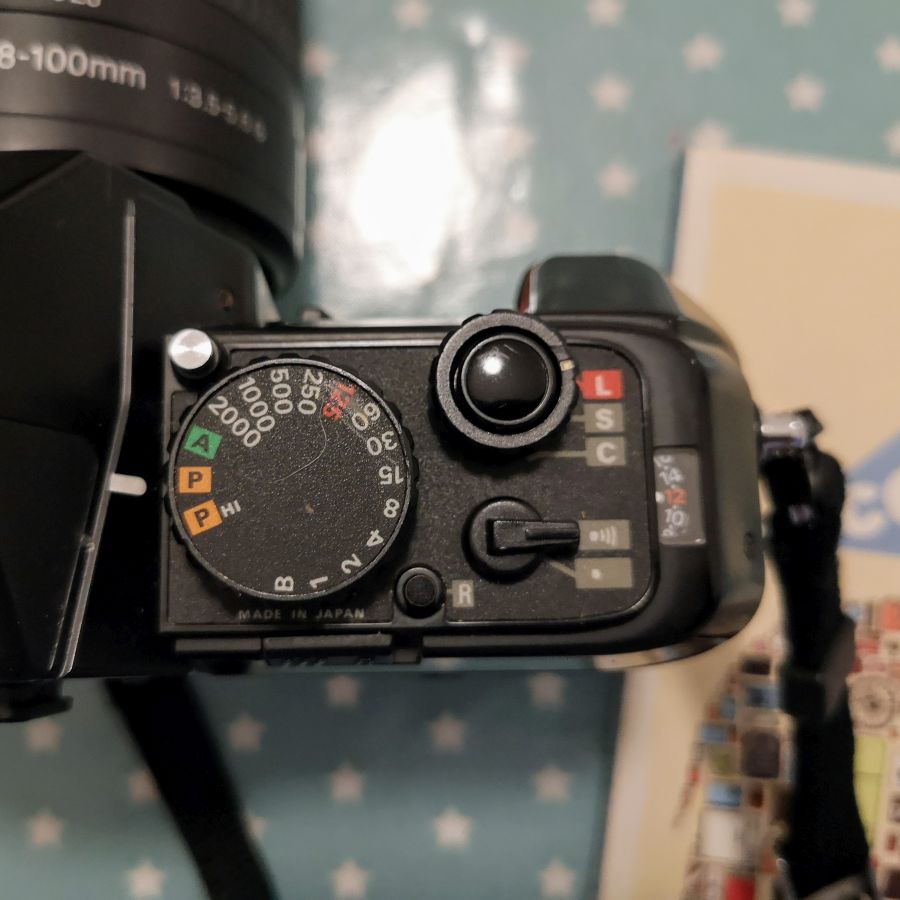
The shutter speed dial offers both fixed shutter speeds for manual modes (M) but also 3 automated modes with stepless shutter (see below). The electronically controlled vertical focal plane shutter goes from 1/2000 to 1 sec plus bulb, but to use that you’ll need to invest in the proprietary MC-12A cable as there’s no standard cable point.
Film speed is set by lifting disk around rewind knob and for the first time has a DX setting. You can over ride this by manually setting film speed. DX coding offers 25-4000 ISO but you can set manually oddly for 12-3200 ISO. The ring doubles as EV compensation (+/- 2EV in 1/3 steps)
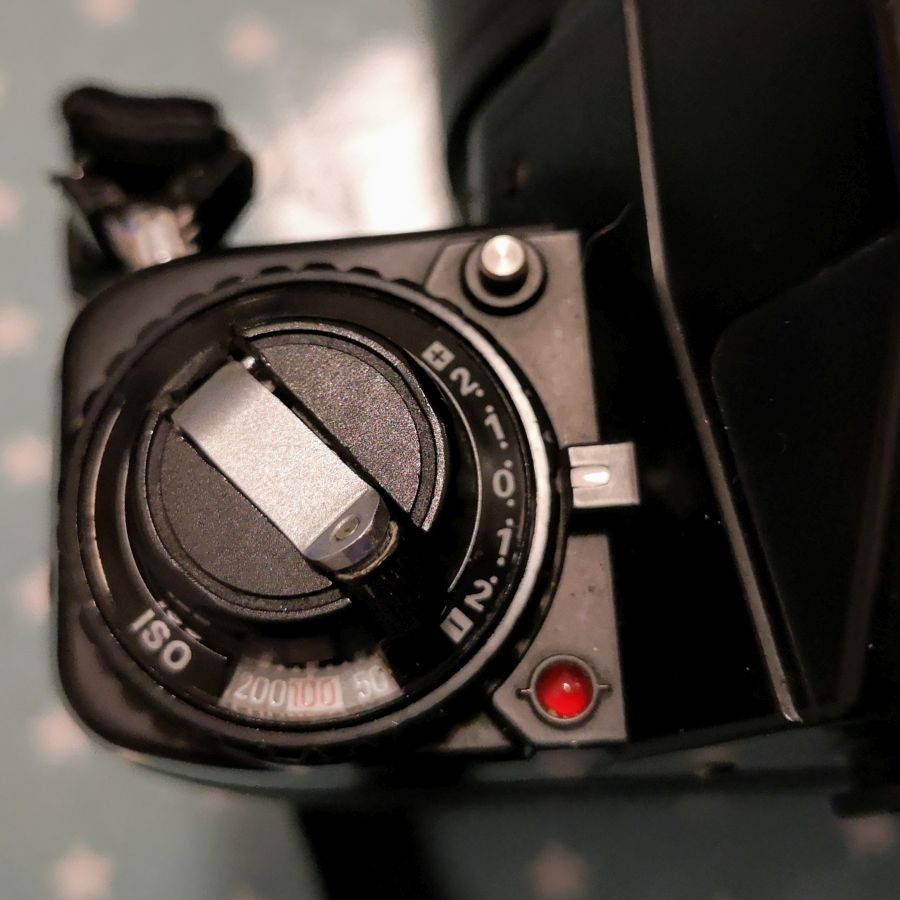
(2) PHI PAM – exposure options
In addition to manual mode, there is A (aperture priority), Program (P) and High speed Program (PHI). As we’ll see not all are supported by all lenses.
To use program with an aperture ring lens you need to set to the smallest aperture. P & PHI use a simplistic linear shutter aperture combo scale. PHI obviously sacrifices aperture to maintain higher shutter speeds. To access and move out of A, P and PHI you need to depress a button.
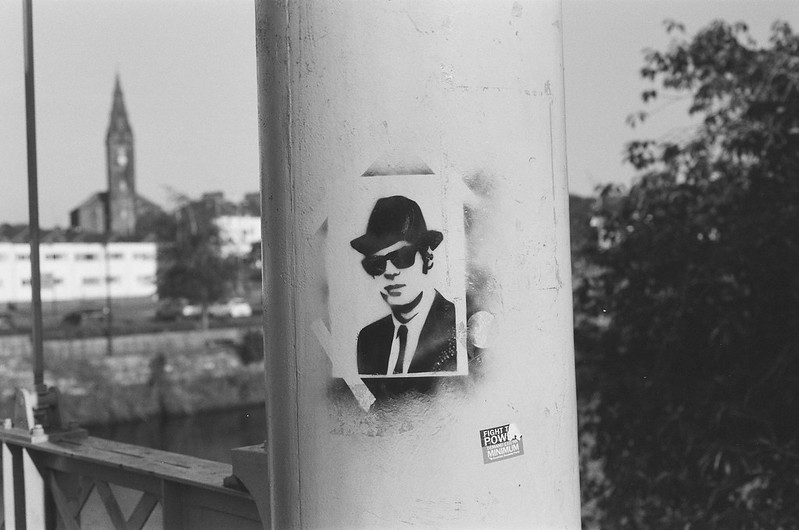
Auto Exposure lock (AEL) is possible by moving in a lever that looks confusingly like a mechanical timer switch.
(3) Flash
On Camera flash would have to wait until the F-401. But we have a camera that supports Nikon Speedlite flash units. Many units will provide TTL modes including modern ones like the SB-600 and SB-800. Non dedicated flash units run risk of frying circuitry.
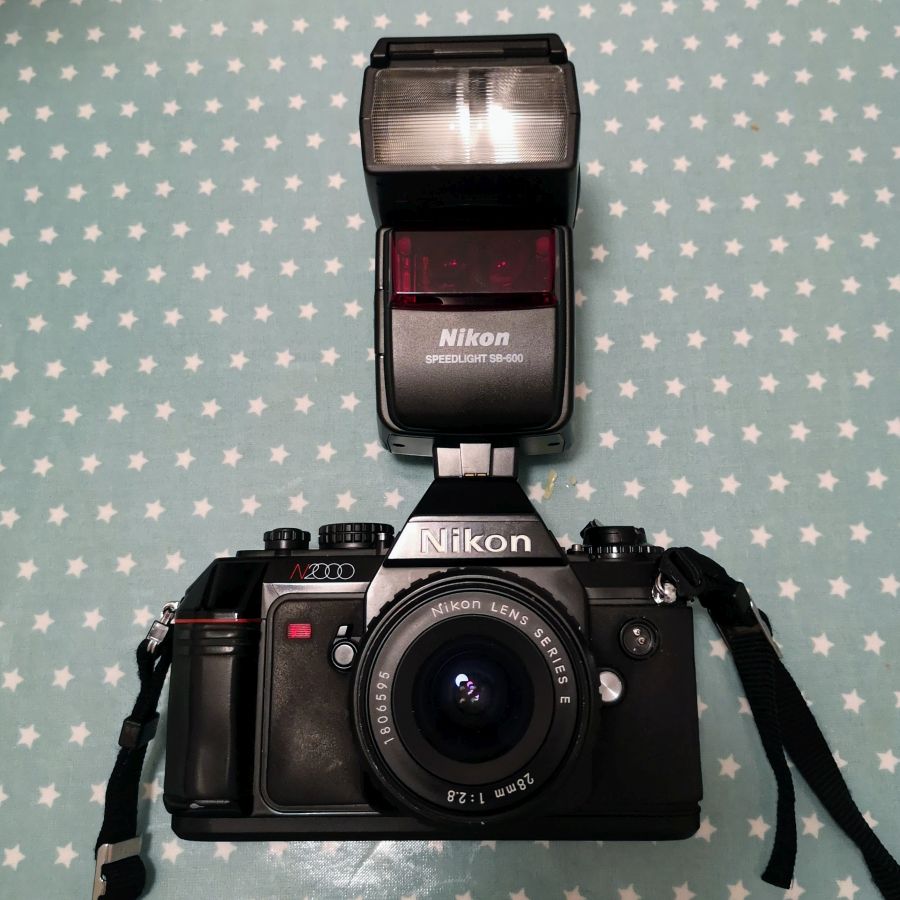
Flash sync is at 1/125. TTL is supported for 25-1000 ISO film speeds. An Electronic timer is triggered by pushing the button on the front of the thing that looks like at timer
(4) Viewfinder
The Viewfinder cover 92% of the frame with X0.85 magnification (50mm lens). It is bright and feature a non interchangeable K2 focus screen. this has a split image ecentral rangefinder surrounded by a microprism collar. A second collar denotes the metering area. K focus screens are the mainstay of Nikon MF SLR. The K2 is the standard screen of the FA, FE2, FM2T, FM10 and FE10 amongst others.

On the right the shutter speed is displayed. In A, P and Phi modes it shows the actual shutter speed. In manual (M) the actual and target shutter speed is shown. Arrows indicate over and under exposure with audible alarm. There is no aperture display
There is also no diopter adjust and the viewfinder isn’t the biggest for a Nikon but at least its okay. I found in Very bright light the number could be a tad hard to see but no where as bad as the Pentax MZ-5.
(5) Power and motordive
Power is via 4xAAA batteries in the base. An optional MB-3 unit gives more power using 4xAA. This trebles the shooting capabilities but given the AAA batteries in theory are good for 60 rolls of 36 exposure, that’s weight I can do without. Worth noting the battery compartment on the base displaces the tripod mount point to one side seriously unbalancing the camera if you haven’t a robust tripod. Nikon did make a centering bracket but this add to the weight
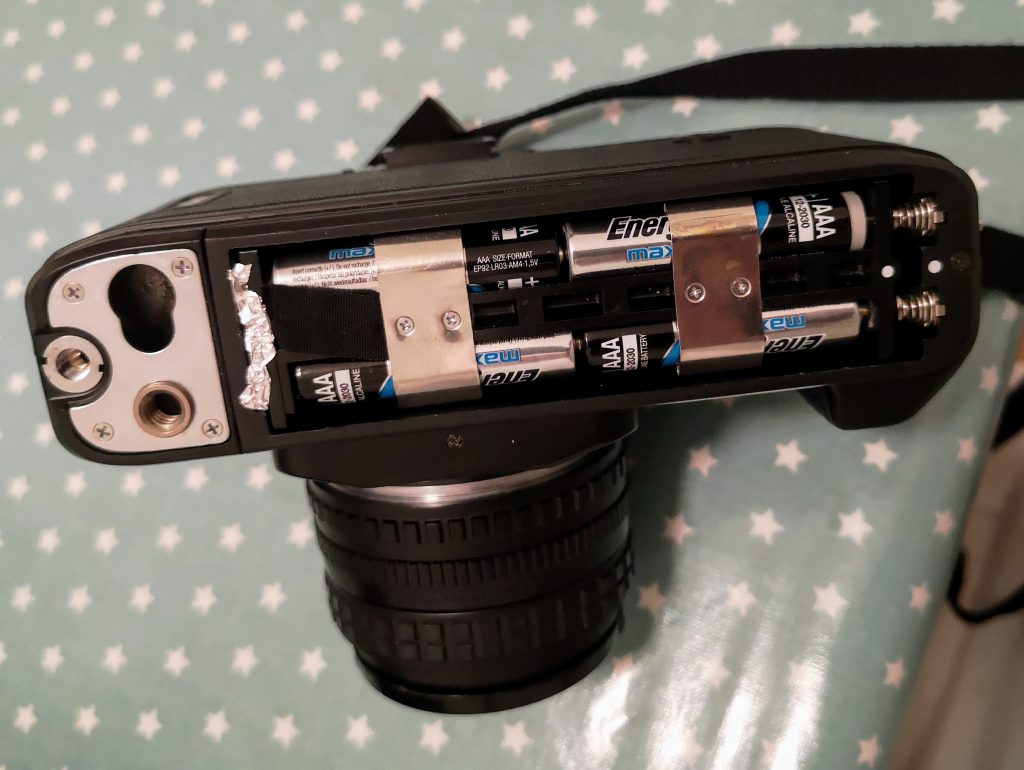
It actually doesn’t weigh that much at 560gms (battery free) compared to earlier Nikons. But compared to later FXX models like the F75 it does feel heavy.
Without batteries the shutter will not fire but that’s a moot point as the camera can’t advance. Funnily enough you’ll need to rewind this camera manually. This involves depressing a button and moving a switch on top plate first.
(6) Lens Compatibility
This is a Nikon F mount SLR that accepts pretty much any Nikon lens made after the AI revision in the 1970’s with the notable exception of AF-P lens (no Nikon film SLR and many a dSLR do not support those). Nor does it work with the newest E (electronic diaphragm) models that lack a mechanical level (not to be confused with older E series Nikon lenses for the EM)
It doesn’t just support these lenses but offers metering meaning I can use a my 28mm 1:2.8 E series lens in all modes. If I compare them to my F55, F65 an d F75 none of these will meter AI and AI-S lenses like the E series.
But the big question in G class lenses. This is a camera that predates that sort of milarky. But on testing it looks like these are supported in P & PHI modes. Jürgen Becker certainly agrees on his blog & Ken Rockwell lists the N2020 as supported. Ken also suggests a hack for the A mode.

And as the camera is ignoring AF systems it will happily work with AF-D and AF-S lenses including my kit 18-55mm AF-S G DX one (just watch out for cropped corners). Whether all modern lens AF-S non E lenses work I can’t guarantee.
This makes it one hell of a flexible Nikon camera unless you have a lot of pre-AI nikon glass.
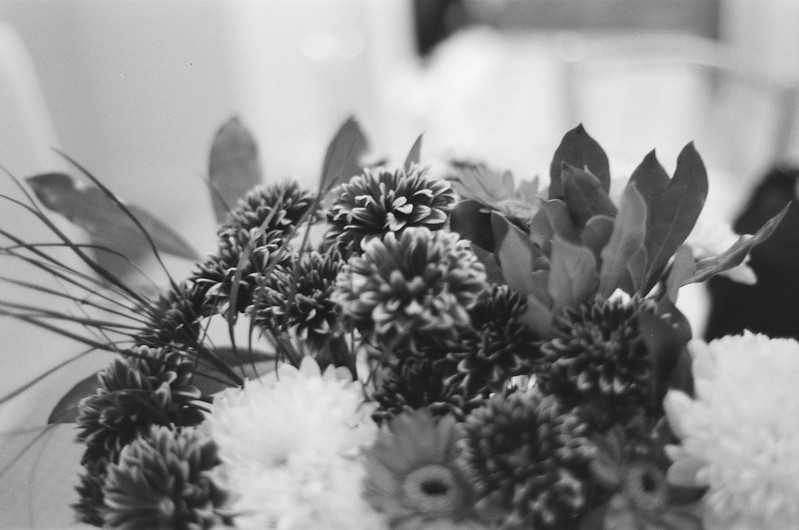
Build
This a well built camera. It looks pretty conventional for a MF bar the handgrip. It thankfully is only available in black. The polycarbon shell is pretty robust and there is no black sticky mess from the rubber grips (ironic as my F75 made 2 decades later is pretty tacky).
The Achilles heel for these is the battery compartment. Using alkaline batteries with a theoretical multiple roll life mean many ended up corroded. Mines was no different but luckily it was just the in camera contacts not the interior electrics so bridging things with Tinfoil worked and a later de-corrosion is on the cards
Use
So it depends if you are and established film shooter or stepping down from digital. If you are used to any MF SLR then this is a breeze. The camera is heavier at 570gms without batteries or lens than newer models. But there is little weight difference to classic era models.

An early gripe is the on/off switch or lack of. Later Nikons have a switch around shutter button. This has a pull up collar to switch between off, single and continuous shooting (2.5fps).
Once on it depends on the mode. It’s pretty logically really. With P and PHI set the lens to narrowest aperture (usually f/22) and the camera does the rest. In A just adjust the aperture.
The motor drive is noisy but in a weird good way. Think Duran Duran Girls on Film here. Not Subtle but really satisfying to someone who spent their teens in the 80’s.
You’ll take a bit of adjusting stepping from a mirrorless or dSLR (try F75) but this is actually little different from classic era SLRs.
What maybe disappoints is the lack of DoF preview. Also the AEL and timer mechanisms IMHO are the wrong way around
And the F3 comparison ?
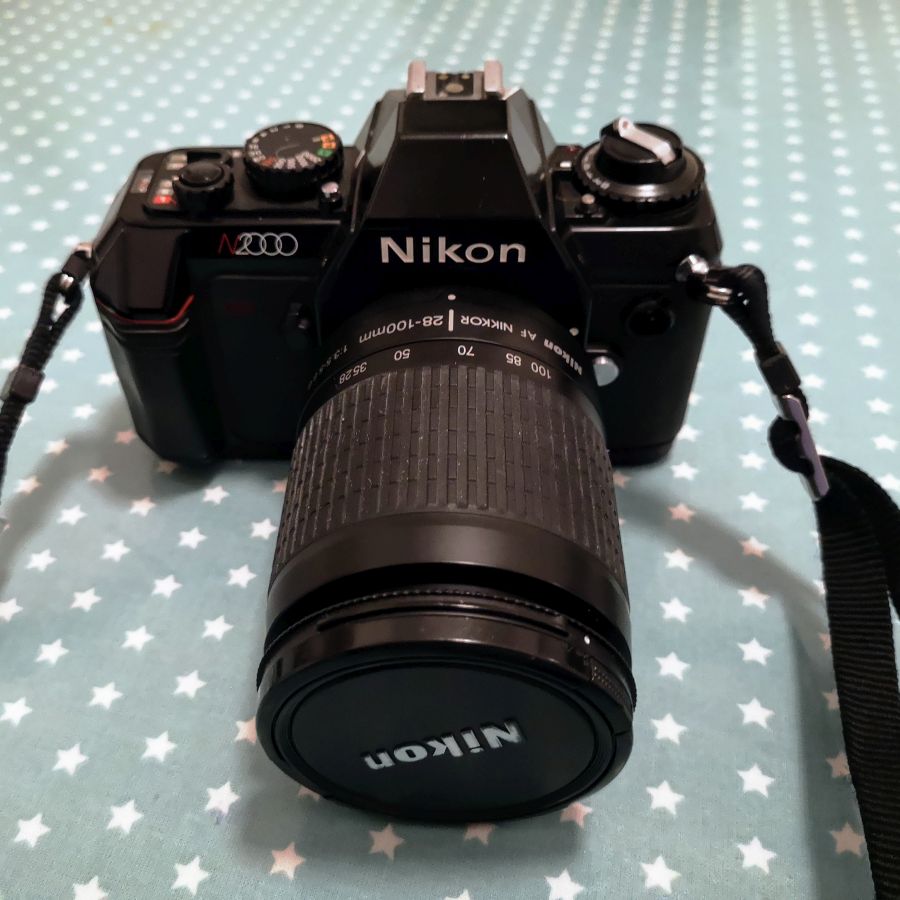
The F3 is one of Nikon’s legendary F professional series cameras. It was the longest produced model – out living it’s successor the F4 by some margin. Regarded by many as the finest Manual focus SLR ever made, it is a true classic.
It addresses the F-301 failings, is much more robust and offers a wider Nikon F mount support including those weird invasive fisheyes from the 1960’s. If the standard body ain’t tough enough for you, there’s titanium or militarised versions. There is a myriad of finder and focus screen combinations and there is it’s unique metering system seen only in the F3. It also will work without batteries (with a fixed emergency shutter speed).
But the F-301 is fairly tough, lighter and offers the same upper shutter speed. Whilst it can’t use pre AI lenses it can unlike the F3 work with G lenses. It also weighs a lot less than a non motor driven F3. It retained a similar layout to the F3 so is intuitive to use bar the annoying on/off cuff.
Results (really no comment)
I don’t comment about results really as with all SLR the images are more to do with Glass I use and my inabilities on the day. The Camera role is pretty limited. That said images are accurately exposed in most lighting situations and in complex stuff I got results I expected.
I used a range of films but the slightly expired Agfaphoto APX100 was back from the labs first.
Conclusion
I ended up liking this camera. May be a plastic camera but it offers much the same functionality as the likes of the FE & FE2 but without their build quality. Plus it has a great support for most (AI onward) lenses with metering across the range.
It also is amongst the cheapest MF nikons you can buy with really only the AP only EM and weird F-601m giving it a run for the £20 or under market. The F-601m is rarer but might suit a dSLR user more. This feels much more old skool however although the AEL is weirdly placed.

But there’s an obvious problem. The F-501 is a few quid more and is the same camera but chucks in AF support (although is a bit more flakey with G lenses). But other AF cameras get even more fruity. I have owned 3 bodies that literally cost around a quid (F-401, F65 & F65) and my trusty F75 that cost a bit more. None of these meter older MF lenses and despite what you read the F55 & F65 have issues with at least some AF-S lenses not just on AF but metering as well. But then again I own a F90X which cost double my N2000 but came with a lens. For that money I can start sniffing after a beat up FG or Chinon made FM10 or FE10.
That said if you want a cheap Nikon MF and can live without DoF this is a good choice as long as the battery compartment ain’t knackered. It has a classical layout too to boot. It really is a a budget F3.
The Bottom Line
Plastictastic this may be, it still offers a Nikon MF SLR for peanuts. Plus one of the best lens supports short of the F professional series. Just make sure the battery compartment ain’t knackered and you can live with a few compromises. This really is the budget beating F3 alternative.
Other sources
Don’t believe me, well Jim Grey seriously loves this cameras. Read his review on Down the Road. Ashley Pomeroy does a seriously good take on this camera including some launch history stuff at Woman & dreams. Ed Worthington gets all Miami Vice with his at 35mmc. Classic Camera have a nice take too.
Mike Eckman does a nice piece on comparing the N2020 (F-501) the AF version with other Nikons.
As mentioned Jim Butkus deserves thanks (and if you can a donation) for making the manual available. Thanks to AG Photolab for processing the roll of APX100 you see used here.


THANK YOU — This is a good, well balanced review and I will second all you have written.
I bought 2 of these F301s over the last coule of years and an F501 to keep my Nikkor options open in the future. The Nikon lenses, when stored well, should last forever, but camera bodies get increasingly hard to repair….so stocking up on inexpensive but useful bodies is a good idea.
These cameras are great for SLOW PHOTOGRAPHY – digital does AF and 6 pictures per second so well that the reason to keep film is to remind yourself HOW to control the exposure triad of ISO, Shutter Speed and Aperture to get it right first time. By slowing down the process, thinking which filter to use to balance and control the light, creativity seems to rise!
And furthermore – even the top end digital sensors can’t do the “roll off” of highlights like film can. So on bright days – always think of taking your old film camera out of the cupboard and “exposing to the right”!
I have the special baseplate option Nikon made for the F301/F501/F3 – it REALLY IS worth finding this as it improves the protection to theotherwise fragile camera base/battery pack cover when in use and makes tripod work MUCH better by centering the otherwise offset tripod bush.
The only problem with the F301 that stops it being perfect is the lack of DoF preview, otherwise this camera is “near perfect”. The autofocus F501 is surprisingly also better as a manual focus camera than as AF – with the AF sensor providing focus confirmation with even the oldest Nikon fit AI/AIS lenses.
Yes – you can us G-mount Nikon lenses on the F301 and F501 in program mode – but that defeats the “slow photography” ethos which makes film photography still so compelling and creative in 2019!
The similar “lost model” in the Pentax range is the P30 – which has everything needed for film photography today – INCLUDING DoF preview, exposure lock and cheap and easy battery compatability as well as a bright focus screen better than near all of the follow up MZ models . It sold in millions and fetches almost nothing. I have a range of the ultra small Pentax SMC PK lenses that I adapted for micro 4/3 when they were launched and M4/3 lenses were expensive or limited in range. Since many of these came with camera bodies I have ended up with a great Pentax SMC lens based system as well.
So now the only question is -with a few camera bodies in store to cope with the inevitable breakdowns over time – how long before 35mm film and processing dries up?
Thanks for the feedback Paul I reviewed the P30 a while a go and agree it’s a great camera (although the original lack the AP mode so I’d always go P30T or P30N). It’s a corker of an overlooked camera.
I’m a bit more hopeful for the future re camera production. Leica and Nikon still make high end bodies and cosina are still making the more mediocre Nikon FM10. Those young disruptors at Lomography pretty much make everything from a SLR to MF bellows. Some are cheesey lo-fi rubbish but things like the LC-A 120 are innovative. We know there’s the demand for film as Kodak’s sales are up. Fujifilm are now launching new films again and Film Ferrania is believed to be about go back into production
You might wish to remove Mike Eckman’s review of the N2000 from article here. He complains quite a bit about how slow the auto focus is on that camera. Hmmmm, could it be that because it’s a manual focus camera? Sorta hard to read the rest of his review after that goof.
Yeah…. Mike reviewed the N2020 (F-501). It is Nikon’s first AF camera and basically the same as the N2000 (F-301) other than having AF control. I included Mike’s excellent review for comparison. I make it clear as does Mike in his article that he’s talking about the N2020 not the N2000. I mention both cameras in my post but Mike’s is included as a review of the N2020 NOT the N2000
F501 for AF ? Really ? Actually, for a decent AF you should get an F100 or upper.
Great review. I bought one for almost nothing and it’s the F3 substitute I needed until I can justify paying for the real thing.
I’m happy to report that I think Paul C’s fears about processing drying up aren’t a concern any more. There is actually a worldwide shortage in colour film right now because the manufacturers can’t keep up with the surging demand. Film is back.
A budget F3 ? And half a budget FE with an equally capable A priority AE. So, for somebody needing AE but don`t need AF, the choice is obvious: F301.